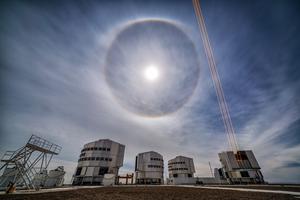Glossarbegriffe: Observatorium
Description: Ein Observatorium (auch Sternwarte genannt) ist ein Ort oder ein Gebäude, das für astronomische Beobachtungen genutzt wird.
Optische und Infrarot-Beobachtungen werden in der Regel mit Teleskopen durchgeführt, die in Kuppeln untergebracht sind, um sie bei schlechtem Wetter zu schützen. Radioteleskope und einige Submillimeterteleskope werden oft im Freien aufgestellt. Moderne bodengestützte optische, Infrarot- oder Submillimeter-Observatorien werden auf Berggipfeln oberhalb eines möglichst großen Teils der Erdatmosphäre errichtet. Diese Observatorien verfügen über spezielle Instrumente wie Teleskope, Kameras und Spektrographen. Für astronomische Observatorien für Radio- und kosmische Strahlung ist ein hoher Standort weniger notwendig. Andere Teile des elektromagnetischen Spektrums (Gammastrahlung, Röntgenstrahlung, ultraviolette Strahlung und langwelligere Infrarotstrahlung) können mit speziellen Weltraumteleskopen untersucht werden, die manchmal auch als Weltraumobservatorien bezeichnet werden. Die Beobachtungen von Radioteleskopen an verschiedenen Standorten können miteinander kombiniert werden. Diese verschiedenen Standorte werden oft als ein einziges Observatorium bezeichnet.
Zugehörige Glossarbegriffe:
- Kosmische Strahlung
- Elektromagnetische Strahlung
- Gammastrahl
- Infrarot (IR)
- Mikrowellen
- Radiowellen
- Teleskop
- Ultraviolett
- Sichtbares Spektrum
- Astronomie der kosmischen Strahlung
- Submillimeter-Astronomie
See this term in other languages
Term and definition status: The original definition of this term in English have been approved by a research astronomer and a teacher The translation of this term and its definition is still awaiting approval
The OAE Multilingual Glossary is a project of the IAU Office of Astronomy for Education (OAE) in collaboration with the IAU Office of Astronomy Outreach (OAO). The terms and definitions were chosen, written and reviewed by a collective effort from the OAE, the OAE Centers and Nodes, the OAE National Astronomy Education Coordinators (NAECs) and other volunteers. You can find a full list of credits here. All glossary terms and their definitions are released under a Creative Commons CC BY-4.0 license and should be credited to "IAU OAE".
If you notice a factual or translation error in this glossary term or definition then please get in touch.
Zugehörige Medien
Chilean observatories at home office, by Robert Barsa, Slovakia
Bildnachweis: Robert Barsa/IAU OAE
License: CC-BY-4.0 Creative Commons Namensnennung 4.0 International (CC BY 4.0) icons
ESO's Very Large Telescope (VLT) at Paranal Observatory with a lunar halo
Bildnachweis: Juan Carlos Muñoz-Mateos/ESO credit link
License: CC-BY-4.0 Creative Commons Namensnennung 4.0 International (CC BY 4.0) icons
Keck Telescopes
Bildnachweis: NASA/JPL credit link
License: PD Public Domain icons
Hubble Space Telescope over Earth
Bildnachweis: NASA/ESA credit link
License: CC-BY-4.0 Creative Commons Namensnennung 4.0 International (CC BY 4.0) icons
Parkes Radio Telescope
Bildnachweis: David McClenaghan/CSIRO credit link
License: CC-BY-3.0 Creative Commons Namensnennung 3.0 Unported icons













